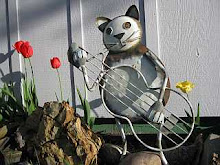Dr. Eric Meyer, a Montana native and Colorado-based anesthesiologist, was part of the nine-person International K2 Expedition team that pushed for the summit of K2 in August 2008. While everyone in the expedition - sponsored by Talus Outdoor Technologies - made it back safely, 11 other climbers lost their lives in snow and ice slides in an area called "The Bottleneck."The lecture was held in Columbia Falls, MT at 7 pm. It had been widely advertised so I made an effort to get there early to get a good seat. Good intention - bad execution. I got there about 10 minutes before the lecture started but not nearly early enough. All the seats were taken and I had to stand along a wall. At least I had a wall to lean against unlike people who came even later. I estimate the overflow crowd that filled the room was around 150 people.
The Bottleneck sits at about 26,000 feet (8,200M) and is only 1,312 feet (400M) below the summit. Climbers refer to this altitude as the "Death Zone," since at that altitude the human body uses up its oxygen faster than it can be replenished.
One member of Dr. Meyer's team reached the summit but Meyer turned back from the summit himself and ended up treating many of the survivors brought back to base camp. Most of them had severe frostbite and suffered from dehydration and exhaustion.
K2 is located in the Himalayan mountain range on the border of Pakistan and China, with an elevation of 28,251 feet (8,611 meters). Although K2 is about 750 feet (228 meters) lower than the world’s tallest peak, Mount Everest, K2 is widely considered a much more difficult and technical climb. Only 299 people have reached the summit of K2 since it was first reached in 1954, just 15 of whom were Americans. 77 climbers have died trying to reach the summit.
Later I saw Peter arrive without Edwina. He too had to stand in the back.
While waiting for everyone to arrive and the lecture to start, the Columbia Falls group (First Best Place) hosting the event gave away free goodies in response to correct answers. People sitting up front had an advantage and got most of the goodies.
The event was co-sponsored by Talus Outdoor Technologies, a local Montana company that makes a face mask for cold weather breathing. A kind of Darth Vader look. Surprisingly the head of Talus brought a keg of beer and people got free beer after the lecture.

 Dr. Meyer looks quite youthful in person. Small, thin and wiry. He grew up in Miles City, Montana and after the lecture I asked how he got so interested in mountain climbing since he grew up on the prairie with nary a mountain in sight. Part of it was that his parents were avid outdoors camping people.
Dr. Meyer looks quite youthful in person. Small, thin and wiry. He grew up in Miles City, Montana and after the lecture I asked how he got so interested in mountain climbing since he grew up on the prairie with nary a mountain in sight. Part of it was that his parents were avid outdoors camping people.His lecture was a combination of photos, video, then a slide show of photos with music. Dr. Meyer talked about the mountain, the expedition, then the day of the ascent when the people died.
He also listed what medical supplies they bring on the expedition. Interestingly Viagra is one of the medicines. Apparently it helps fight high altitude sickness. Dr. Meyer said a German study found Viagra boosted physical performance. People snickered and Dr. Meyer said the tests were done on volunteers riding bicycles.
This is the third time he gave this lecture and the first with all the photos and video. It was quite an interesting talk but I could tell it was new and he was still in the process of refining it. The video was home movies and came across that way. The video needed more editing to help tell the story and integrate more into the story and photos.
From all the heavy breathing and slow movement in the video I could see how tired the climbers were up there. The mountain's steepness didn't help either.
One climber lost nine of his ten toes to frostbite. The photos showing the frostbite were gruesome. Part of me would like to climb one of these mountains, but after seeing the frostbite... maybe not.
I spoke with Dr. Meyer after the lecture to make sure I understood correctly the number of men who died, and that other than the first two fatalities, they were the men who didn't make it down past the ice slide during the descent.
Dr. Meyer encouraged my interest in climbing. Age seems not to be a major factor in climbing - younger is not always better. Mental attitude plays a larger role. While he was going to medical school in Seattle Dr. Meyer worked as a climbing guide on Mt. Rainer. He encouraged me to climb Rainer. I do have an interest in Rainer and relatives near there; I just need to find someone who'd want to go on a guided climb with me.
Back home I found an article online that explained the tragedy more clearly.



No comments:
Post a Comment